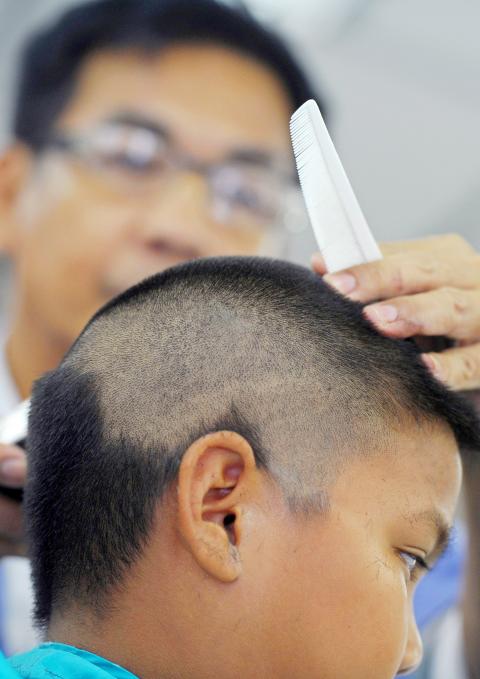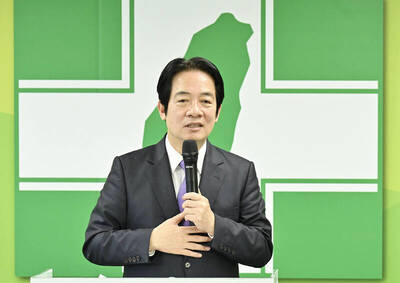Pudding-bowl bobs and army-type cuts were for decades the only hairstyles allowed to be sported by Thai schoolchildren — but now looser rules spell new freedom for classroom coiffures.
“I am embarrassed having this kind of hairstyle,” 14-year-old Visarut Rungrod told AFP, running his hand over his close-cropped head, adding he plans to lengthen his locks as soon as possible.
“I will feel more confident when I go out,” he explained.

PHOTO: AFP
Rules issued in 1972 compelled Thai pupils to have identical hairstyles — a trim not below the earlobes for girls and a maximum five-centimeter length for boys — until the end of high school.
But students are now hoping to flaunt their individuality after an edict by Thailand’s education ministry in May scrapped the measure.
The issue, in a nation which emphasizes collective culture over individualism, was sparked by an anonymous complaint by a 15-year-old student to the National Human Rights Commission of Thailand in 2011, saying the strict rules violated human rights and freedom.
“It made adolescent students lack confidence and lose concentration in studying,” the student said in the letter, which won mass support across social media among teenagers.
The letter stirred debate in a country where the education system often faces accusations of promoting rigid conformity over creativity and independent thought.
Under the new rules, girls are able to grow their hair long — although they will have to wear it tied back in matching ponytails — while boys can grow their hair to the nape of their neck.
As fashions changed, a small number of schools had already allowed girls to grow their hair long, as long as it was kept tidy, but the May rule change has brought newfound freedom to teenagers across the kingdom.
Last bastion
Not everyone is happy. Some teachers and parents fear doing away with the traditional tresses is the start of a wider unraveling of Thailand’s appreciation for conformism.
“They must all have short hair otherwise there will be a lot of varied hairstyles [in schools],” said 56-year-old father, Pornyudh Budhapongsiriporn, whose sons are 12 and 15.
“If most students have a short haircut, the rest should have short hair — otherwise they won’t fit in with society.”
For parents like him, all is not lost in the battle to preserve conformity. The government still gives teachers ultimate authority to decide their school’s hair policy.
“Among our teachers and school committees, the resolution was that all students should have the old hairstyle,” said Ratchanee Prapasapong, director of Makutkasatriyaram School in Bangkok.
“Though hairstyle has nothing to do with teaching, we see it as a kind of discipline for living together in society. It also shows that younger ones respect [and] still want to keep the traditional culture of older generations,” she added.
Experts suggest that the new rule may indeed herald a wider move away from that traditional culture and say it has troubled the conservative older generations.
“They are very confused that all of a sudden students have long hair,” Somphong Chitradub, an education expert at Bangkok’s Chulalongkorn University, told AFP.
“But it [the freedom to grow their hair] develops children to show their real feelings — it will make them feel good,” Somphong added.
One objection is that pupils will be distracted from their textbooks by the pursuit of funky new hairstyles. Some parents also fear increased body awareness may push their children prematurely towards having boyfriends or girlfriends.
It is an idea rubbished by Somphong, who says those fears smack of paranoia as it is “inner discipline,” and not hairstyles, that dictates pupils’ application at school.
“Parents and teachers do not understand the real needs of the students, although they have good intentions by thinking for the kids,” Somphong said.
“They should teach the kids about life skills and building self-discipline.”
For most pupils, the issue is simply about choice and does not carry much wider social meaning.
“It depends on us how much we want to pay attention to studying or to beauty,” said Pattanotai Tungsuwan, a 14-year-old female student with a silky black ponytail. “For me I would rather pay attention to my studies.”

May 11 to May 18 The original Taichung Railway Station was long thought to have been completely razed. Opening on May 15, 1905, the one-story wooden structure soon outgrew its purpose and was replaced in 1917 by a grandiose, Western-style station. During construction on the third-generation station in 2017, workers discovered the service pit for the original station’s locomotive depot. A year later, a small wooden building on site was determined by historians to be the first stationmaster’s office, built around 1908. With these findings, the Taichung Railway Station Cultural Park now boasts that it has

Wooden houses wedged between concrete, crumbling brick facades with roofs gaping to the sky, and tiled art deco buildings down narrow alleyways: Taichung Central District’s (中區) aging architecture reveals both the allure and reality of the old downtown. From Indigenous settlement to capital under Qing Dynasty rule through to Japanese colonization, Taichung’s Central District holds a long and layered history. The bygone beauty of its streets once earned it the nickname “Little Kyoto.” Since the late eighties, however, the shifting of economic and government centers westward signaled a gradual decline in the area’s evolving fortunes. With the regeneration of the once

The latest Formosa poll released at the end of last month shows confidence in President William Lai (賴清德) plunged 8.1 percent, while satisfaction with the Lai administration fared worse with a drop of 8.5 percent. Those lacking confidence in Lai jumped by 6 percent and dissatisfaction in his administration spiked up 6.7 percent. Confidence in Lai is still strong at 48.6 percent, compared to 43 percent lacking confidence — but this is his worst result overall since he took office. For the first time, dissatisfaction with his administration surpassed satisfaction, 47.3 to 47.1 percent. Though statistically a tie, for most

In February of this year the Taipei Times reported on the visit of Lienchiang County Commissioner Wang Chung-ming (王忠銘) of the Chinese Nationalist Party (KMT) and a delegation to a lantern festival in Fuzhou’s Mawei District in Fujian Province. “Today, Mawei and Matsu jointly marked the lantern festival,” Wang was quoted as saying, adding that both sides “being of one people,” is a cause for joy. Wang was passing around a common claim of officials of the People’s Republic of China (PRC) and the PRC’s allies and supporters in Taiwan — KMT and the Taiwan People’s Party — and elsewhere: Taiwan and